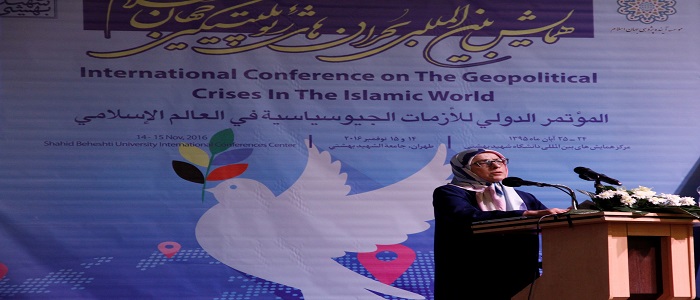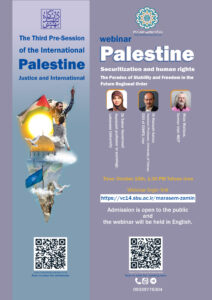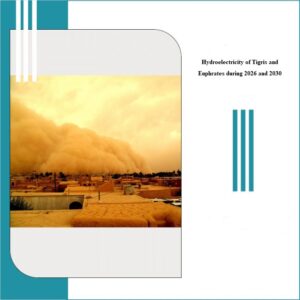“Backgrounds and Aspects of Geopolitical Crises in Central Asia: an Emphasis on Ethnic Ties”
Speech by Dr. E. Kula’ee;
Head of Regional Studies Department of University of Tehran
International Conference on the Geopolitical Crises in the Islamic World/14th November 2016
greetings, I am honored to be addressing such a distinguished audience and appreciate the efforts of the head and managing director of IIWFS for focusing on this wide and important matter in Islamic world and creating the opportunity to discuss on internal and external factors of geopolitical crises in the region.
Thanks for the time given to me to talk about one of the most important regions (Central Asia) which as a part of Islamic world, following the collapse of the Soviet Union, has faced many ups and downs and political, economic and social developments and has turned into one of the focal points of the geopolitical crises among Islamic countries.
I did not have the opportunity to attend the previous sessions and take advantage of the distinguished lecturers. I hope that the discussions held in these 2 days can help us toward a clear and real understanding on effective factors of emergence of these geopolitical crises. Professors, students and experts very well know that there are a broad set of discussions on affective role and factors, whether internal or external, on these emerging crises.
A large part of these theories and views focus on external and internal factors. Anyway, I hope that we can achieve a realistic and balanced approach to deal effectively with these crises effectively and our discussions here lead us toward this aim.
The region I focused on geographically constitutes our country’s northern frontier with Central Asia which has experienced the far-reaching and crucial presence of Russian states for more than 10 years; whether during the Soviet era or before that in Tsarist Russian era. I would focus on what we have faced during the past 25 years since the collapse of the Soviet Union which were like geopolitical crises in this region; and that they were the heir of which of the Soviet Union era’s developments and contexts.
The image formed after the collapse of Soviet Union in early decades of the 20th century and creating new conditions in the politics and economy of this region, there was a powerful view that despite Soviet policies of Russification in decades for Muslims of Central Asia, yet Islamic identity did not diminish by ethnic state-building frameworks of the Soviet Union.
According to Russians themselves, they tried systematically and scientifically to diminish the Islamic identity; but finishing the Soviet Union era, it was revealed that Islamic identity and the component of Islam in Central Asia is an integral part of people’s identity in this region.
An important point is that Russian ethnic state-building heritage in central Asia which became the basis in this region since the formation of the Soviet Union and ethnicities became the basis for state formations, was not doubted and denied in post- Soviet atmosphere; but in this region, as a result of such heritage, whatever known as borders and known as means of division between countries were not taken into account.
Specifically, I focus on Afghanistan and Tajikistan in which the ethnic ties facilitate the waves of Islamic extremism and Islamic radicalization in both Tajikistan and in countries bordering Afghanistan. In fact we face a very close relationship between political developments in Afghanistan during the civil war, during the fighting with Red Army, after the collapse of Red Army in Gorbachev era and even in the post-independence era between two countries. The waves of civil war in Tajikistan and after that the support of the ones who wanted to fail the structure of power after the collapse entered Tajikistan from Afghanistan.
Such proximity, interference and ethnic ties in Tajikistan’s civil war -as a very affecting incident and occurrences in this region- facilitated the transfer of experiences, attitudes and views to occur easily and rapidly. What we witnessed in Tajikistan’s civil war is similar to what happened during the guerrilla war (Mujahedin Battle) with the Soviet Union; that there, Tajikistan became the point for transferring the forces and facilities from the Soviet Union to fight Mujahedin. Again after the collapse of Soviet Union, we can see that Afghanistan’s Tajiks support opponents of Dushanbe administration in Tajikistan; and it is to the extent that when in 1990s Taliban expanded its penetration to the north, we see that a strong and powerful supporter of Dushanbe administration’s opponent is vanishing. It means that the expansion of Taliban’s penetration in Afghanistan reveals the powerful backing of Dushanbe Administration’s opponents; therefore sustain of bases, supports and logistics equipment in Afghanistan from Rabbanie’s administration and Ahmad Shah Masud became impossible. It can be observed that Iran and Russia were cooperating to put an end to the conflict. It was a good opening; especially for Russia to witness the effective role of Islamic republic of Iran in providing security and stability in Central Asia and Caucasus in an effective and significant experience, and it can provide the basis for many cooperation and efforts in future.
The cooperation between Iran and Russia to put an end to the civil war in Tajikistan had an effective role in the wide-spreading process between the two countries.
Such interference is very important and must be investigated in the context of geopolitical crises in Central Asia; and that is because of its immediate and direct effect it has on the attitudes of the Central Asia elites regarding the role of Russia, position of Russia and the relation with Russia on one hand, and in Moscow regarding the relation with surrounding republics on the other hand. In order to set relations with other countries in Central Asia and Caucuses and also countries around Russia, Tajikistan can be a model among surrounding republics which completely transforms the concepts of independence, parting, and the concept for the possibility of parting Russia’s interests from the interests of ruling elites in these republics.
Such development which is really fundamental, would affect the Russian role and influence in surrounding republics; and the climax of its role and influence may be what we witnessed in Ukraine in recent years.
Changing attitudes toward the role of Russia in surrounding republics; These are all geopolitical capacities which were denied by simplification of the collapse that dreamed about the possibility of mere changes in these areas regardless of geographic, neighborhood factors, and interference and ethnic ties; for example about Russian people in surrounding republics, especially in Central Asia, Tajikistan and Afghanistan. It took not a long time that it imposed its adverse effects on the decision makers of not only republics of the Central Asia and Caucuses but also on those in Moscow.
Geopolitical facts cannot be denied; none of the leaders in these countries, neither in the Soviet Union era nor after the collapse of the Soviet Union, paid attention to the matter and denied these facts. The denial of geopolitical facts and the role of geography, especially in developments occurred after the collapse of the Soviet Union, had been prevalent; and it should be taken into account in northern boarders of our country more than any time before.
It seems that on one hand geographical considerations caused by geographical neighboring among Central Asia republics and on the other hand with our country and entrance of Central Asia Countries into Islamic Countries- due to its immortal and stable identity in this region- as well as Russian’s attitude and role toward the region are affected by ethnic and racial factors and as mentioned before it is rooted in ethnic state- building model implemented during the Soviet Union era. I hope that I could better elaborate the matter in my printed article.





